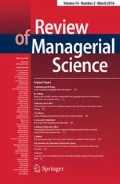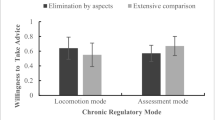Abstract
This paper builds on behavioral strategy and strategic decision making literatures to propose a stronger integration of information acquisition behaviors in debiasing research. We argue that the advice-seeking behavior of executives—as their dominant way of information acquisition—may have a fundamental effect on cognitive biases in individual judgment. Empirical results of a vignette-based survey of 186 top executives in German SMEs support this claim. We posit that internal and external advice affect individual judgment differently and that external advice, in particular, is likely to be effective for debiasing. These results suggest new avenues for debiasing research that go beyond the active intervention techniques that have been the focus of debiasing research thus far.
Similar content being viewed by others
References
Agle BR, Mitchell RK, Sonnenfeld JA (1999) Who matters to CEOs? An investigation of stakeholder attributes and salience, corporate performance, and CEO values. Acad Manag J 42(5):507–525
Agle BR, Nagarajan NJ, Sonnenfeld JA, Srinivasan D (2006) Does CEO charisma matter? An empirical analysis of the relationships among organizational performance, environmental uncertainty, and top management team perceptions of CEO charisma. Acad Manag J 49(1):161–174
Alexiev AS, Jansen JJP, Van den Bosch FAJ, Volberda HW (2010) Top management team advice seeking and exploratory innovation: the moderating role of TMT heterogeneity. J Manage Stud 47(7):1343–1364
Arkes HR (1991) Costs and benefits of judgment errors: implications for debiasing. Psychol Bull 110(3):486–498
Atuahene-Gima K, Li H (2004) Strategic decision comprehensiveness and new product development outcomes in new technology ventures. Acad Manag J 47(4):583–597
Balkundi P, Harrison DA (2006) Ties, leaders, and time in teams: strong inference about network structure’s effects on team viability and performance. Acad Manag J 49:49–68
Barnes JH (1984) Cognitive biases and their impact on strategic planning. Strateg Manag J 5(2):129–137
Bazerman MH, Moore DA (2008) Judgment in managerial decision making. Wiley, Hoboken
Belsley DA, Kuh E, Welsch R (1980) Regression diagnostics: identifying influential data and sources of collinearity. Wiley, New York
Blenko MW, Mankins MC, Rogers P (2010) The decision-driven organization. Harvard Bus Rev 88(6):54–62
Bonaccio S, Dalal RS (2006) Advice taking and decision-making: an integrative literature review, and implications for the organizational sciences. Organ Behav Hum Decis Process 101(2):127–151
Bradfield RM (2008) Cognitive barriers in the scenario development process. Adv Dev Hum Resour 10(2):198–215
Carmeli A, Schaubroeck J (2006) Top management team behavioral integration, decision quality, and organizational decline. Leadersh Q 17(5):441–453
Chatterjee A, Hambrick DC (2007) It’s all about me: narcissistic chief executive officers and their effects on company strategy and performance. Adm Sci Q 52:351–386
Churchill GA (1991) Marketing research: methodological foundations. Dryden, Chicago
Cruz CC, Gómez-Mejia LR, Becerra M (2010) Perceptions of benevolence and the design of agency contracts: CEO-TMT relationships in family firms. Acad Manag J 53(1):69–89
Das TK, Teng B-S (1999) Cognitive biases and strategic decision processes: an integrative perspective. J Manag Stud 36(6):757–778
Druckman JN (2001) Using credible advice to overcome framing effects. J Law Econ Organ 17(1):62–82
Duhaime IM, Schwenk CR (1985) Conjectures on cognitive simplification in acquisition and divestment decision making. Acad Manag Rev 10(2):287–295
Durand R (2003) Predicting a firm’s forecasting ability: the roles of organizational illusion of control and organizational attention. Strateg Manag J 24(9):821–838
Eddleston KA, Kellermanns FW, Sarathy R (2008) Resource configuration in family firms: linking resources, strategic planning and technological opportunities to performance. J Manag Stud 45(1):26–50
Eisenhardt KM (1989) Making fast strategic decisions in high-velocity environments. Acad Manag J 32(3):543–576
Forbes DP (2007) Reconsidering the strategic implications of decision comprehensiveness. Acad Manag Rev 32(2):361–376
Fredrickson JW (1984) The comprehensiveness of strategic decisions processes: extension, observations, future directions. Acad Manag J 27(3):445–466
Fredrickson JW, Mitchell TR (1984) Strategic decision processes: comprehensiveness and performance in an industry with an unstable environment. Acad Manag J 27(2):399–423
Hambrick DC, Mason PA (1984) Upper echelons: the organization as a reflection of its top managers. Acad Manag Rev 9(2):193–206
Hart S, Banbury C (1994) How strategy-making processes can make a difference. Strateg Manag J 15(4):251–269
Heyden MLM, van Doorn S, Reimer M, Van Den Bosch FAJ, Volberda HW (2013) Perceived environmental dynamism, relative competitive performance, and top management team heterogeneity: examining correlates of upper echelons’ advice-seeking. Organ Stud 34(9):1327–1356
Hodgkinson GP, Bown NJ, Maule AJ, Glaister KW, Pearman AD (1999) Breaking the frame: an analysis of strategic cognition and decision making under uncertainty. Strateg Manag J 20(10):977–985
Hodgkinson GP, Maule AJ, Bown NJ (2004) Causal cognitive mapping in the organizational strategy field: a comparison of alternative elicitation procedures. Organ Res Methods 7(1):3–26
Huff AS (1990) Mapping strategic thought. Wiley, Chichester
Kahneman D, Klein G (2009) Conditions for intuitive expertise a failure to disagree. Am Psychol 64(6):515–526
Kahneman D, Lovallo D (1993) Timid choices and bold forecasts: a cognitive perspective on risk taking. Manage Sci 39(1):17–31
Kahneman D, Tversky A (1979) Prospect theory: an analysis of decision under risk. Econometrica 47(2):263–291
Kahneman D, Tversky A (2000) Choices, values, and frames. Cambridge University Press, Cambridge
Karasz A, Mckinley PS (2007) Cultural differences in conceptual models of everyday fatigue a vignette study. J Health Psychol 12(4):613–626
Katz R, Allen TJ (1982) Investigating the not invented here (NIH) syndrome: a look at the performance, tenure, and communication patterns of 50 R & D project groups. R&D Manag 12(1):7–20
Langer EJ (1975) The illusion of control. J Pers Soc Psychol 32(2):311–328
Langer EJ (1983) The psychology of control. Sage, Beverly Hills
Larrick RP (2004) Debiasing. In: Koehler DJ, Harvey N (eds) Blackwell handbook of judgment and decision making. Blackwell Publishing, Oxford
Ling Y, Kellermanns FW (2010) The effects of family firm specific sources of TMT diversity: the moderating role of information exchange frequency. J Manage Stud 47(2):322–344
Ling Y, Simsek Z, Lubatkin MH, Veiga JF (2008) The impact of transformational CEOs on the performance of small- to medium-sized firms: does organizational context matter? J Appl Psychol 93(4):923–934
Lovallo D, Sibony O (2010) The case for behavioral strategy. McKinsey Q 2:30–43
Lubatkin MH, Simsek Z, Ling Y, Veiga JF (2006) Ambidexterity and performance in small-to medium-sized firms: the pivotal role of top management team behavioral integration. J Manag 32(5):646–672
McDonald ML, Westphal JD (2003) Getting by with the advice of their friends: CEOs’ advice networks and firms’ strategic responses to poor performance. Adm Sci Q 48(1):1–32
McDonald ML, Khanna P, Westphal JD (2008) Getting them to think outside the circle: corporate governance, Ceos’ external advice networks, and firm performance. Acad Manag J 51(3):453–475
Meissner P, Wulf T (2013) Cognitive benefits of scenario planning: its impact on biases and decision quality. Technol Forecast Soc Change 80(4):801–814
Menon T, Thompson L, Choi H-S (2006) Tainted knowledge vs. tempting knowledge: people avoid knowledge from internal rivals and seek knowledge from external rivals. Manag Sci 52(8):1129–1144
Milkman KL, Chugh D, Bazerman MH (2009) How can decision making be improved? Perspect Psychol Sci 4(4):379–383
Miller D, Dröge C (1986) Psychological and traditional determinants of structure. Adm Sci Q 31(4):539–560
Miller CC, Burke LM, Glick WH (1998) Cognitive diversity among upper-echelon executives: implications for strategic decision processes. Strateg Manag J 19(1):39
Mussweiler T, Strack F, Pfeiffer T (2000) Overcoming the inevitable anchoring effect: considering the opposite compensates for selective accessibility. Pers Soc Psychol Bull 26(9):1142–1150
Podsakoff PM, MacKenzie SB, Lee J-Y, Podsakoff NP (2003) Common method biases in behavioral research: a critical review of the literature and recommended remedies. J Appl Psychol 88(5):879
Presson PK, Benassi VA (1996) Illusion of control: a meta-analytic review. J Soc Behav Personal 11(3):493–510
Priem RL, Rasheed AMA, Kotulic AG (1995) Rationality in strategic decision processes, environmental dynamism and firm performance. J Manag 21(5):913–929
Salancik GR, Pfeffer J (1977) Who gets power—and how they hold on to it: a strategic-contingency model of power. Org Dyn 5(3):2–21
Salk JE, Brannen MY (2000) National culture, networks, and individual influence in a multinational management team. Acad Manag J 43(2):191–202
Salomon JA, Tandon A, Murray CJL (2004) Comparability of self rated health: cross sectional multi-country survey using anchoring vignettes. BMJ 328(7434):258
Saunders C, Jones JW (1990) Temporal sequences in information acquisition for decision making: a focus on source and medium. Acad Manag Rev 15(1):29–46
Schoemaker PJH (1993) Multiple scenario development: its conceptual and behavioral foundation. Strateg Manag J 14(3):193–213
Schulze WS, Lubatkin MH, Dino RN, Buchholtz AK (2001) Agency relationships in family firms: theory and evidence. Organ Sci 12(2):99–116
Schwenk CR (1984) Cognitive simplification processes in strategic decision-making. Strateg Manag J 5(2):111–128
Schwenk CR (1985) Management illusions and biases: their impact on strategic decisions. Long Range Plan 18(5):74–80
Schwenk CR (1988) The cognitive perspective on strategic decision making. J Manage Stud 25(1):41–55
Schwenk CR (1995) Strategic decision making. J Manag 21(3):471–493
Simon M, Houghton SM, Aquino K (2000) Cognitive biases, risk perception, and venture formation: how individuals decide to start companies. J Bus Ventur 15(2):113–134
Simsek Z, Veiga JF, Lubatkin MH, Dino RN (2005) Modeling the multilevel determinants of top management team behavioral integration. Acad Manag J 48(1):69–84
Sniezek JA, Van Swol LM (2001) Trust, confidence, and expertise in a judge-advisor system. Organ Behav Hum Decis Process 84(2):288–307
Soll JB (1999) Intuitive theories of information: beliefs about the value of redundancy. Cogn Psychol 38(2):317–346
Soll JB, Larrick RP (2009) Strategies for revising judgment: how (and how well) people use others’ opinions. J Exp Psychol Learn Mem Cogn 35(3):780–805
Srivastava MK, Gnyawali DR (2011) When do relational resources matter? Leveraging portfolio technological resources for breakthrough innovation. Acad Manag J 54(4):797–810
Stolte JF (1994) The context of satisficing in vignette research. J Soc Psychol 134(6):727–733
Thomas JB, Clark SM, Gioia DA (1993) Strategic sensemaking and organizational performance: linkages among scanning, interpretation, action, and outcomes. Acad Manag J 36(2):239–270
Thompson T, Barbour R, Schwartz L (2003) Adherence to advance directives in critical care decision making: vignette study. BMJ 327(7422):1011
Wally S, Baum JR (1994) Personal and structural determinants of the pace of strategic decision making. Acad Manag J 37(4):932–956
Wang L, Zajac EJ (2007) Alliance or acquisition? A dyadic perspective on interfirm resource combinations. Strateg Manag J 28(13):1291–1317
Wright G, Goodwin P (2002) Eliminating a framing bias by using simple instructions to ‘think harder’ and respondents with managerial experience: comment on ‘breaking the frame’. Strateg Manag J 23(11):1059–1067
Yaniv I (2004) Receiving other people’s advice: influence and benefit. Organ Behav Hum Decis Process 93(1):1–13
Zajac EJ, Bazerman MH (1991) Blind spots in industry and competitor analysis: implications of interfirm (mis)perceptions for strategic decisions. Acad Manag Rev 16(1):37–56
Zellweger TM, Kellermanns FW, Chrisman JJ, Chua JH (2011) Family control and family firm valuation by family CEOs: the importance of intentions for transgenerational control. Organ Sci 23(3):851–868
Acknowledgments
We thank Tomi Laamanen, Thomas Hutzschenreuter, and Peter Kesting for their valuable comments on earlier versions of this manuscript. In addition, we would like to thank editor Wolfgang Kürsten as well as the two anonymous reviews for their extremely helpful feedback on the article.
Author information
Authors and Affiliations
Corresponding author
Appendix: Questionnaire and variable scales
Appendix: Questionnaire and variable scales

Rights and permissions
About this article
Cite this article
Meissner, P., Wulf, T. Debiasing illusion of control in individual judgment: the role of internal and external advice seeking. Rev Manag Sci 10, 245–263 (2016). https://doi.org/10.1007/s11846-014-0144-6
Received:
Accepted:
Published:
Issue Date:
DOI: https://doi.org/10.1007/s11846-014-0144-6




